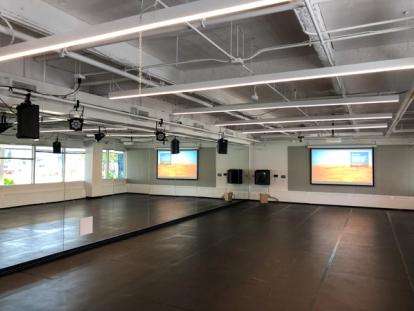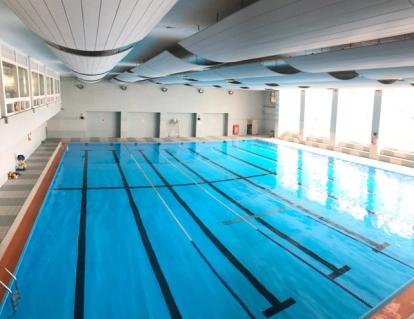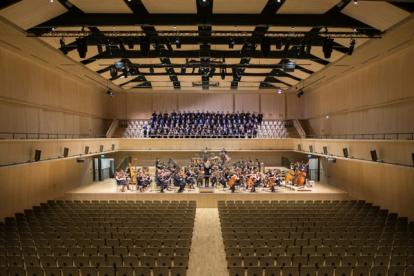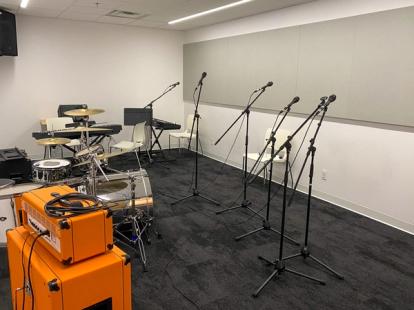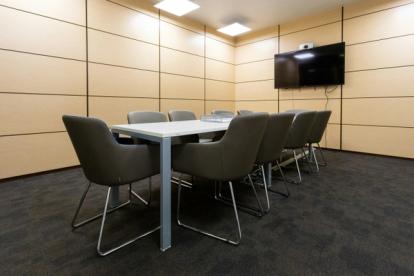
A sound decision: Selecting the right acoustic treatment for your architectural project
- Post Date
- 24 April 2024
- Read Time
- 10 minutes

Have you ever found yourself struggling to hear a presenter at a conference, a colleague during a virtual meeting, or a flight announcement in a busy airport? Whether it's a meeting room, classroom, open office, restaurant, or concert hall, the quality of sound within a space profoundly influences our ability to communicate, interact, learn, and enjoy various activities.
In the world of architectural design, achieving appropriate room acoustics is essential for creating accessible, user-friendly, and acoustically comfortable spaces. To achieve desirable acoustics quality in a space, carefully considered acoustic treatment is needed. This simple guide outlines some of the key considerations to help you select and specify acoustic treatment that supports the intended usage of your space.
Room Acoustics
Room acoustics design refers to the application of materials, products, and design strategies to control and improve the sound quality within a space. This idea is often confused with sound isolation, which aims to mitigate unwanted sound transmission between spaces (and is sometimes misleadingly referred to as “soundproofing”).
Poor room acoustics is a common shortfall in communication-critical spaces, such as teleconference rooms or classrooms. Late sound reflections can interfere with direct speech signals and cause speech intelligibility issues for both listeners and speakers. Careful design of acoustic finishes and treatment can significantly enhance speech clarity and audibility, where absorptive materials, such as acoustic panels, ceiling tiles, and wall coverings, are used to address sound reflections and control reverberation.
With a plethora of acoustic products to choose from, selecting the right options for you and your project can be daunting. From establishing design criteria to assessing product-specific acoustic test data, several key considerations can guide you through the treatment selection process and help you create an appropriate acoustics environment for your architectural project.

Setting the Stage
Before specifying acoustic finishes, it's essential to understand the space’s intended use and corresponding acoustics requirements.
Reverberation Time (RT) is a measure of the rate of decay of sound in a room that quantifies how reverberant or “echoey” a space is. RT depends on the space’s volume and acoustics properties of the room’s surfaces. Larger volume spaces with significant amounts of hard, reflective surfaces such as glazing typically see a greater persistence of sound and are at greater risk for excessively high reverberation.
Room acoustics design targets for speech-intensive usages are often specified using the RT60 parameter. RT60 is the time in seconds for sound to decay by 60 dB and is typically assessed at mid-frequencies between 500 to 2000 Hz. Examples of space and usage-specific RT design criteria in Calgary, Alberta, Canada, include LEED v4.1’s Acoustic Performance Credit Reverberation Time criteria for new construction or Alberta Infrastructure’s Technical Design Requirements for provincial facilities.
The space’s primary function, whether for meetings, conversations, open plan use such as large multi-user offices, musical performances, or amplified speech and presentations, helps to inform a suitable RT target. Variable targets and acoustic treatment may be needed for mixed and multi-use spaces.
Early identification of spaces with potential communication challenges, such as large volume spaces or rooms with rounded walls, is crucial early in the design phase. When in doubt, it is best to seek guidance from an acoustics consultant early in the design process. Doing this from the onset is best, as retrofits are often more costly and time-intensive than proactive design efforts.
Design Considerations
Various design constraints should be considered before selecting finishes and products to meet RT targets for acoustically important spaces. These can include:
Available Surfaces
One of the goals of acoustic treatment is to control reverberation through acoustic absorption, often in place of otherwise hard and reflective surfaces. There are several treatment options, the most common being ceilings and walls, such as absorptive panels, tiles, baffles, or specialty plaster. Typically, a combination of ceiling and wall treatment is used, but there may be other options available depending on the desired outcome.
Ceilings are often the first area to consider. They are typically one of a room’s larger, uninterrupted surface areas and do not interfere with end users. Other options may be considered for an alternative or exposed ceiling finish, such as mass timber buildings where wood and similar biophilic design elements are key to the design vision.
Wall treatment can similarly take on several forms, shapes, and sizes. Some common options include fabric-wrapped panels and stretched fabric systems or perforated materials with concealed absorption. Strategic placement of this treatment is key to optimizing a room’s acoustics and making the best use of the space’s available surfaces.
An acoustics consultant can help you design whether ceiling-mounted, wall-mounted, or a combination of both treatments is necessary to achieve the desired room acoustics characteristics while balancing aesthetics and other practical limitations.
Aesthetics
While performance is crucial, the aesthetic design of acoustic treatments is often a dictating constraint. Designers generally desire treatments that complement the overall design aesthetic and architectural style of the space. Acoustic treatment can take on a variety of finishes, with product appearances ranging from typical soft fabrics to custom printed images, to perforated metal, faux wood, or specialty plaster. By identifying your preferences and exploring all available options, you can make the most informed decision.
In some spaces, acoustic finishes can be a focal point of the design—with extravagant and effective baffle and panel systems becoming a highlight of the space itself. In other instances, acoustic treatment may be more hidden, letting other elements of the space shine through. These treatment options might include finishes like perforated wood, metal, or drywall that conceal their sound-absorbing properties. Additional acoustic enhancements could come in other forms such as heavy curtains and carpets or acoustic light fixtures. The wide variety of finishes and materials offered for modern acoustic treatment make it simple to achieve a cohesive aesthetic without sacrificing acoustic performance.

Budget
Budget considerations are inevitable in any architectural project, but they shouldn't compromise acoustic performance. Oftentimes, the upfront cost of acoustic treatments may be balanced with their long-term benefits, such as improved productivity and occupant satisfaction. Similarly, when specifying acoustic treatment, consider the lifecycle cost of the treatments, including installation, maintenance, longevity, and replacement.
The best approach to budget constraints is to optimize your acoustic treatment strategy by selecting performance finishes and placing them strategically within a space. An acoustics consultant can work with you and local suppliers to explore cost-effective options without compromising on quality or aesthetics.
Sustainability
Green building design and certification is a goal for many architectural and construction projects. Selecting sustainable acoustic finishes can help meet these project-specific environmental targets.
Look for products made from recycled or renewable materials to minimize environmental impact and the embodied carbon associated with acoustic finishes in your building. Consider certifications such as LEED to ensure products meet stringent sustainability standards and evaluate the manufacturing process and end-of-life considerations to make environmentally responsible choices.
Project Requirements
Consider all unique project-specific design constraints, such as the need for washable and cleanable surfaces in vivarium, laboratory, or healthcare environments; moisture-resistant finishes in pools or natatoriums; and impact-resistant panels for high-traffic corridors or gymnasiums, and select products that meet these requirements accordingly.
Before making a final decision, it's advisable to request a sample of the chosen acoustic treatment: Compare samples from different manufacturers to determine which product best meets your criteria and ensure suitability for your project.
Acoustic Performance
Not all acoustic treatment is created equal. In most cases, the goal of acoustic treatment is to achieve a controlled and spectrally well-balanced acoustic environment. Keep in mind the following acoustic performance considerations to create an optimal solution for your space.
Noise Reduction Coefficient (NRC)
Most products are quantified by an overall Noise Reduction Coefficient (NRC) value, which is a single number rating from 0.0 to 1.0 describing the average mid-frequency sound absorption performance of a material or product. A value of 0.0 is essentially a reflective surface, and a value of 1.0 indicates a fully acoustically absorptive surface. As a result of the standardized testing methodology, some products can obtain an NRC value greater than 1.0. Generally, acoustic finishes with a higher NRC rating are preferred to provide greater amounts of absorption with less required treated surface area.
Absorption Coefficients by Octave Band
NRC is a useful metric, but it doesn’t tell the whole story. As an average value, two materials can have an equal overall NRC rating, but very different absorptive spectra. Additionally, NRC only considers the absorptive performance of the 250, 500, 1000, and 2000 Hz octave bands, while the normal frequency range of human hearing typically spans from 20 to 20,000 Hz. Low-frequency performance, which can be critical for some project applications, is therefore not addressed by NRC alone. Some acoustic treatments, such as thin felt, may be marketed as acoustic products but will only provide low amounts of absorption and at higher frequencies alone, leading to a room with a booming sound or “honk”.
When comparing treatment options, look beyond NRC ratings for detailed absorption performance by octave bands. This is typically provided by reputable suppliers alongside a corresponding acoustic test report detailing the test procedure and results.
Mounting Method
While assessing acoustic performance data, particular attention should be paid to the test condition’s mounting method, and whether it matches that of your specific project application. The absorptive performance of materials can be tested under a variety of mounting configurations. This method matters and can have a significant impact on the reported acoustic performance. In some instances, reported absorptive performance may be misleading when compared to final installation.
Selecting acoustic treatments for your architectural project requires careful consideration of various factors, including design constraints such as budget and aesthetics, as well as absorptive performance. By considering the combination of factors described above, you can create spaces with exceptional sound.
For expert guidance and support in selecting, designing, and installing acoustic treatment for your next project, get in touch. Our team of experts is here to help you achieve your acoustics goals and create accessible spaces that look and sound great.
Recent posts
-

-

Understanding sound flanking: Fire alarm speaker cable conduits in multi-family buildings
by Neil Vyas
View post -


